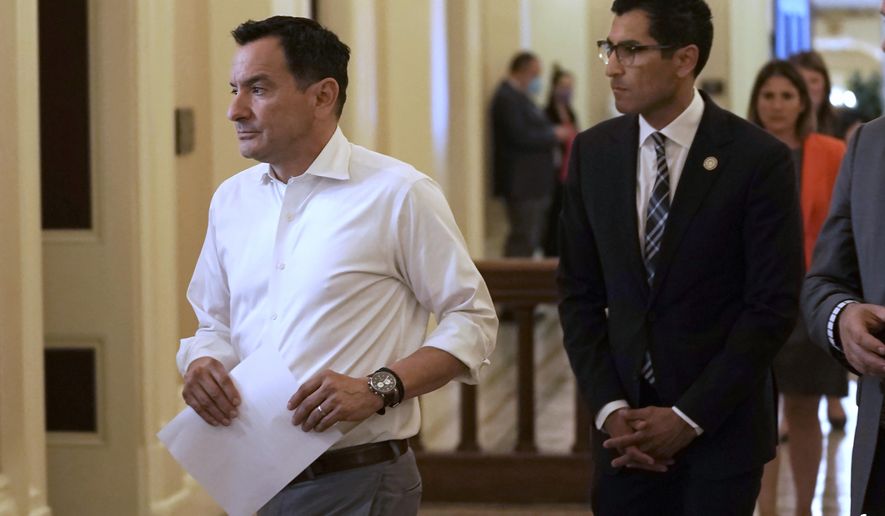SACRAMENTO, Calif. — An unusually high number of California lawmakers will be gone after the November election due to a collision between redistricting in 2020 and changes to term limits that voters approved a decade ago.
The turnover has groups cheering the opportunity to increase lawmakers’ gender and ethnic diversity. Advocacy group Close the Gap celebrated what executive director Susannah Delano called “ the Motherlode of open seats” and a “once-in-a-generation opportunity” to reshape the Legislature over the next six years.
A quarter of the 40-member Senate is being replaced this fall, with seven members termed out of office and three others not seeking reelection. No members of the 80-member Assembly are termed out, but 22 members who will reach their 12-year term limit to serve over the next six years opted not to seek reelection this year.
Half of the Senate is up for election every two years, while all Assembly members run every two years. But this year even the incumbents are running in legislative districts that were redrawn after the census.
Gone due to term limits, for instance, is Sen. Bob Hertzberg, a former Assembly speaker and Senate majority leader perhaps best known recently for unsuccessfully pursuing bail reform. Assemblyman Brian Maeinschein, a fellow Democrat, is among those endangered by redistricting after just authoring a law prompted by Britney Spears’ bad experience with California’s conservatorships law.
Still, Democrats’ overwhelming majorities in both chambers seem safe.
Senate Republicans gave away one seat (see below). And six Assembly members - five of them Republicans - were drawn into three districts, guaranteeing losses for three incumbents, including at least two from the GOP.
Here’s a look at some of the top races:
SENATE DISTRICT 4
Republicans hold just nine Senate seats. But they helped Democrats when six GOP candidates split the primary vote to replace retiring Sen. Andreas Borgeas in this rural Central Valley and Eastern Sierra district. Two Democrats prevailed under California’s primary system, which advances the top two vote-getters no matter their party affiliation. The Democratic Party is backing labor leader Tim Robertson over charter school administrator Marie Alvarado-Gil.
SENATE DISTRICT 16
Sen. Melissa Hurtado moved into this southern San Joaquin Valley district to avoid a primary contest with fellow Democratic incumbent Anna Caballero. Hurtado defeated two Democratic rivals, but now faces Republican David Shepard. Democrats hold a 13 percentage point voter registration advantage, but the California Target Book, which tracks legislative contests, puts that within Republicans’ reach because Central Valley voters tend to be more conservative.
SENATE DISTRICT 20
Hertzberg is termed out, but is trying to pass the torch to son Daniel Hertzberg. The San Fernando Valley district is safely Democratic, but Hertzberg finished neck-and-neck with fellow Democrat Caroline Menjivar in the June primary. The elder Hertzberg is meanwhile running for the Los Angeles County Board of Supervisors.
ASSEMBLY DISTRICT 7
Democratic Assemblyman Ken Cooley is a top target for Republicans in his suburban Sacramento district where the Democratic voter advantage narrowed to 5 percentage points after redistricting. Cooley’s primary campaign focused television ads on an obscure member of the extremist Proud Boys in what Republicans called an effort at misdirection. The GOP’s endorsed candidate still advanced: Josh Hoover, an Assembly aide to congressional candidate Kevin Kiley.
ASSEMBLY DISTRICT 40
Redistricting was not kind to Republican Assemblywoman Suzette Martinez Valladares. She flipped what had been a Democratic seat two years ago, but 42% of voters in the redrawn Los Angeles County district are registered Democrats to Republicans’ 29%. She received less than half the vote in a three-way primary race, a subpar “flashing warning sign” for November, says the California Target Book that tracks legislative contests. She faces labor organizer Pilar Schiavo.
ASSEMBLY DISTRICT 76
Maeinschein was a Republican before he switched parties in 2019, criticizing then-President Donald Trump. Now he’s seeking reelection in a San Diego County district that’s slightly less friendly after redistricting, though Democrats still hold a 6 percentage point voter registration edge. His “anemic showing” with just under half the primary vote “could set off alarms,” says the Target Book, but he faces Republican Kristie Bruce-Lane, whose “strident, red-meat campaign” may be too conservative for the moderate district.




Please read our comment policy before commenting.